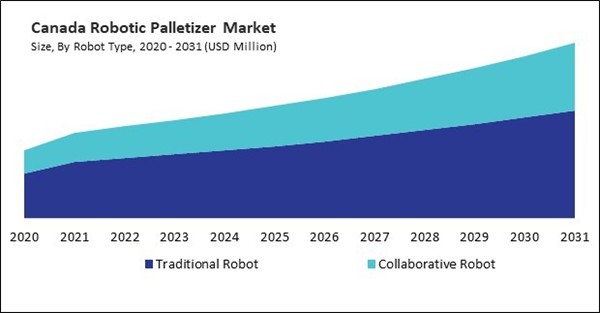The US market dominated the North America Robotic Palletizer Market by Country in 2023, and would continue to be a dominant market till 2031; thereby, achieving a market value of $556.7 million by 2031. The Canada market is experiencing a CAGR of 7.7% during (2024 - 2031). Additionally, The Mexico market would exhibit a CAGR of 7% during (2024 - 2031).
The market refers to the industry segment encompassing the production, distribution, and utilization of robotic systems designed for palletizing tasks. These palletizers are automated machines equipped with robotic arms or manipulators that handle the stacking and arrangement of goods onto pallets in warehouses, manufacturing facilities, distribution centers, and logistics operations.
The adoption of these palletizers has seen a significant rise across industries, driven by their compelling advantages over traditional manual palletizing methods. Several factors contribute to the increasing adoption of these palletizers. For instance, these palletizers eliminate the need for manual labor in palletizing tasks, reducing reliance on human operators for repetitive and physically demanding work. This leads to labor savings, improved workplace safety, and reduced risk of injuries associated with manual handling.
Robotic palletizers enable food and beverage companies in Canada to palletize products faster and more accurately compared to manual methods. As per the Government of Canada, in 2022, the food and beverage processing industry was the largest manufacturing industry in Canada in terms of production value, with sales of goods manufactured worth $156.5 billion. In 2022, the export of processed food and beverage products reached a historic high, totaling $54.3 billion, marking a 14.1% surge compared to the previous year. These exports constituted 34.7% of the total production value. Similarly, these palletizers enable e-commerce warehouses in Mexico to palletize orders quickly and accurately, reducing order processing times and improving order fulfilment efficiency. According to the International Trade Administration (ITA), the domestic e-commerce industry was valued at USD 26.2 billion in 2022, representing a 23 per cent increase over 2021. Mexico ranks among the top five nations globally regarding the growth rate of e-commerce retail. In 2022, the country boasted 63 million e-commerce users, reflecting a rise of 5.5 million compared to the previous year. Mexico’s e-commerce sector value will reach USD 70.4 billion by 2027. Thus, the growing e-commerce sector and the growing food and beverage industry in the region are driving the market’s growth.
Based on Robot Type, the market is segmented into Traditional Robot, and Collaborative Robot. Based on Component, the market is segmented into Robotic Arm, End-of-Arm Tooling (EOAT), Control System, and Others. Based on Application, the market is segmented into Boxes & Cases, Pails & Drums, Bags, and Others. Based on End-Use, the market is segmented into Food & Beverages, Chemical, E-Commerce & Logistics, Pharmaceutical, Cosmetic & Personal Care, and Others. Based on countries, the market is segmented into U.S., Mexico, Canada, and Rest of North America.
List of Key Companies Profiled
- FANUC Corporation
- Kuka AG (Midea Group Co., Ltd.)
- ABB Ltd.
- Krones AG
- Schneider Packaging Equipment Company, Inc. (Pacteon Group)
- Honeywell International Inc
- Kaufman Engineered Systems
- Concetti S.p.A.
- Brenton, LLC (Pro Mach, Inc.)
- Rothe Packtech Pvt. Ltd.
- KION GROUP AG
Market Report Segmentation
By Robot Type
- Traditional Robot
- Collaborative Robot
By Component
- Robotic Arm
- End-of-Arm Tooling (EOAT)
- Control System
- Others
By Application
- Boxes & Cases
- Pails & Drums
- Bags
- Others
By End Use
- Food & Beverages
- Chemical
- E-Commerce & Logistics
- Pharmaceutical
- Cosmetic & Personal Care
- Others
By Country
- US
- Canada
- Mexico
- Rest of North America
Table of Contents
Companies Mentioned
- FANUC Corporation
- Kuka AG (Midea Group Co., Ltd.)
- ABB Ltd.
- Krones AG
- Schneider Packaging Equipment Company, Inc. (Pacteon Group)
- Honeywell International Inc
- Kaufman Engineered Systems
- Concetti S.p.A.
- Brenton, LLC (Pro Mach, Inc.)
- Rothe Packtech Pvt. Ltd.
- KION GROUP AG









